The Semantic Web
Tim
Berners-Lee and Eric
Miller
W3C World Wide Web Consortium
Slides available at:
http://www.w3.org/Talks/2002/01/10-video/
The Semantic Web
- Background and Philosophy
- Architecture and Enabling Technologies
- Deployment Plan
- Future Directions
Background - Pre Web
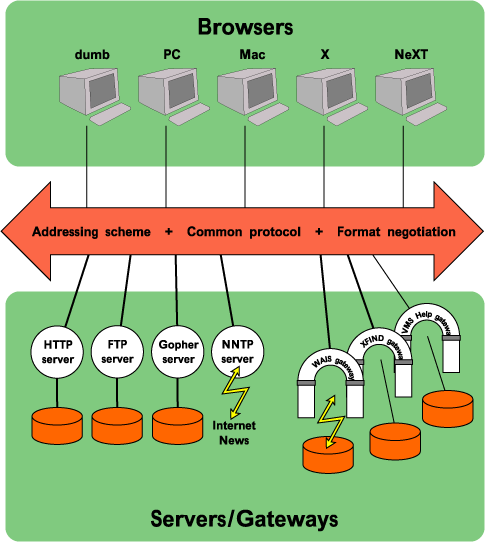
The Current Web
- Resources:
- identified by URI's
- Links:
- User:
- exciting world - meaning of the documents clear from
content
- Machine:
- very little information available - significance of the links
only evident from the context around the anchor.
|
View Source and alternate png, gif images |
The Semantic Web: The original web realized
Information Management: A Proposal, Tim Berners-Lee, CERN, March 1989, May
1990,
http://www.w3.org/History/1989/proposal.html
Web of relationships amongst named objects
->
unified information management tasks.
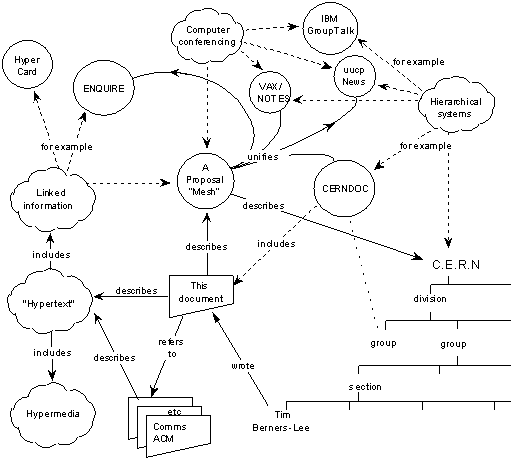
The Semantic Web - A Simple Extension to the Current Web
- Resources and Links:
- identified by URI's
- Resources:
- may be strongly typed
- User:
- even more exciting world
- Machine:
- more information available
- Computers and people:
- work, learn and exchange knowledge effectively
|
View Source and alternate png, gif images |
W3C SW Activity - Goals
- Design of technologies that support machine facilitated global
knowledge exchange.
- "Join the Web", provide the enabling infrastructure for application
data integration on the web.
- Making it cost-effective for people to record their knowledge.
- Focus on machine consumption
| "The bane of my existence is doing things that I
know the computer could do for me."
-- Dan Connolly, The XML Revolution
|

|
Semantic links - "Joining the Web"
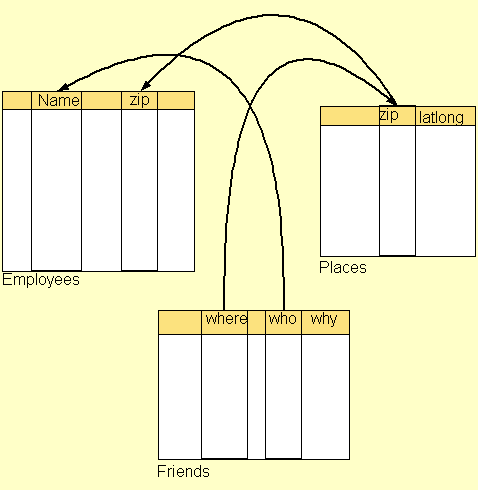
W3C SW Activity - Structure
W3C SW Activity - Approach to Deployment
A lot of hard work - and a bit of luck
- Foster an environment for effective cooperation and collaboration
- Establish guiding architectural principles
- Facilitate the design of enabling standards and technologies
- Understand policy implications
- Focus on short term deployment
- Eye toward longer term research issues
SW Principles 1: Everything Identifiable is on SW
- All resources have identity
- People, places, and things in the physical world have online
representations identified by URI's.
- URI's support participation, effective integration and are
contextualized in SW.
|

|
SW Principles 2: Partial Information
- The current Web is unbounded.
- Sacrifices link integrity for scalability.
- The Semantic Web it unbounded.
- Anyone can say anything about anything.
- There will always be more to discover.
|

|
SW Principles 3: Web of Trust
- All statements on the Web occur in some context.
- Applications need this context in order to evaluate the trustworthiness
of the statements.
- The machinery of the SW does not assert that all statements found on
the Web are "true".
- Truth - or more pragmatically, trustworthiness - is evaluated by each
application that processes the information on the Web.
SW Principles 3: Web of Trust
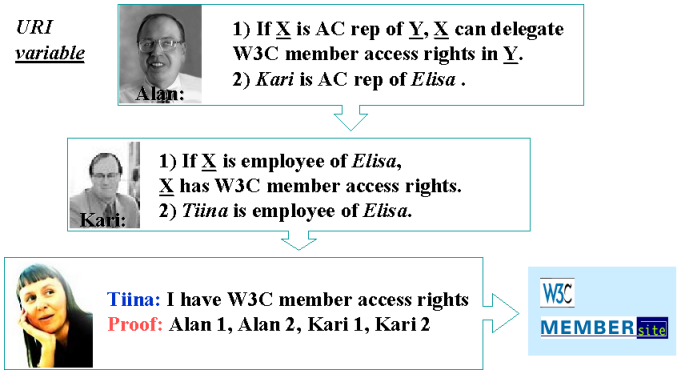
SW Principles 4: Evolution
- Allow effective combination of the independent work of diverse
communities.
- Support the ability to add new information without insisting that the
old be modified.
- Provide communities the ability to resolve ambiguities and clarify
inconsistencies.
- Use descriptive conventions that can expand as human understanding
expands.
SW Principles 5: Minimalist Design
- Make the simple things simple, and the complex things possible.
- Enable simple applications now that plan for future complexity (eg.
Dublin Core, RSS, MusicBrainz)
- Standardize no more than is necessary.
- Result more than the sum of the parts
Enabling Standards & Technologies - Layer Cake
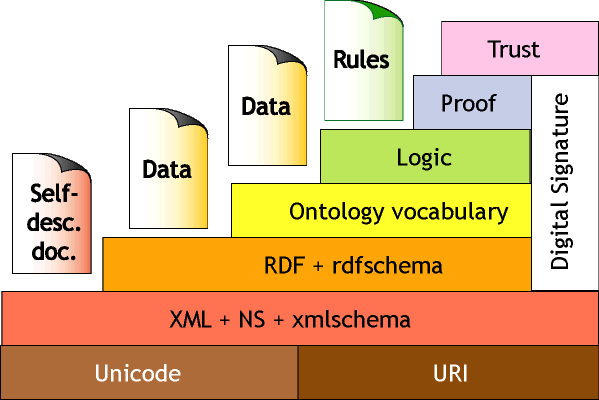
Entities and Relations
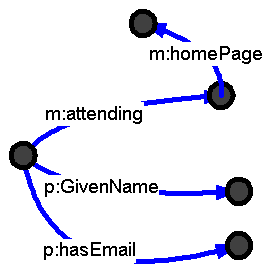
...superimpose
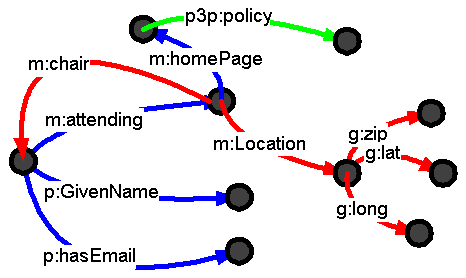
RDF+Schema layer
- Minimalist model - (thing), Class, Property
- Subproperty, Subclass
- Domain & Range
- Comments & labels
Very wide interoperability
Ontology layer
- More metainformation, such as
- Transitive property
- Unique, Unambiguous, Cardinality, etc
- Ontology community exists- DL, OIL, SHOE, etc. etc.
- Huge extra usage for extra functionality
- Not Turing complete
Wide interoperability & interconversion
Rules Layer
- General purpose rules languages that allow query and filtering
- Query similar to SQL
- Many rules systems currently exist
- Rules layer allows Proofs without full Logic layer
Logic layer
- Universal language for monotonic logic
- Any rule system can export, generally cannot import
- No one standard engine - inference capabilities differ
- Many engines exist (SQL to KIF, Cycl, etc)
- Any system can validate proofs
Semantic Web bus
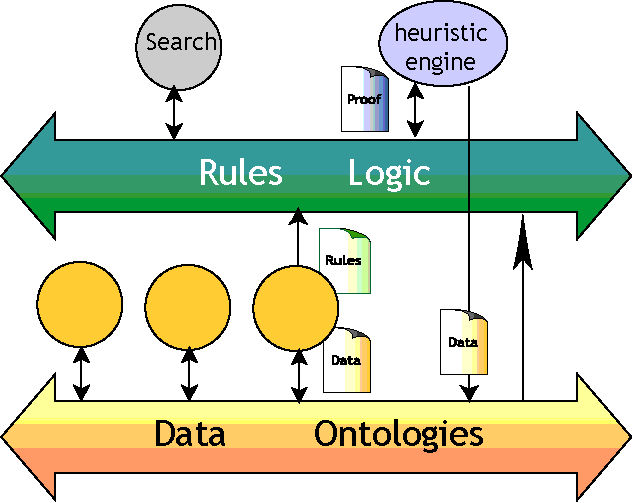
Where we are at currently
- Enabling Standards and Technologies for supporting the Architecture
- Semantic Web / RDF Interest Group
- RDF Rules / Query
- RDF Logic
- Advance Development
- Testing out specifications and corresponding interaction
- Applications for Services, Preferences, Policies, Signatures
(Trust), etc.
More information








